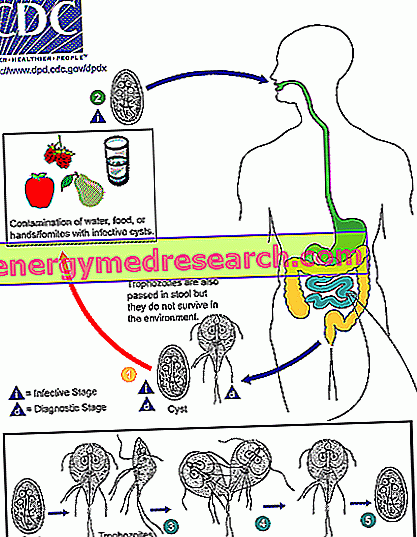Generality
Giardia lamblia (also known as Giardia intestinalis and G. duodenalis ) is a flagellated protozoan responsible for an intestinal disease known as giardiasis, lambliasis or more simply giardia.
The parasite has a biological cycle characterized by a cystic stage (resistant form) and a trophozoite stage (vegetative form). It is widespread all over the world, although - favored by precarious hygienic conditions - it prefers temperate and tropical regions; for this reason giardia is much more common in developing countries - where it reaches an incidence of 20-30% - compared to the more industrialized nations.

Contagion
Transmission occurs through the ingestion of food or water contaminated by parasite cysts; particularly at risk are tourists from tropical regions, where giardia is one of the etiological agents most often responsible for traveler's diarrhea. Giardia can also be transmitted by inter-human contact, for example when the hands are not properly washed after going to the toilet or handling diapers. Finally, giardia can be transmitted via sexual contact, as happens during the oral-rectal or oral-genital contacts. The risk of infection is in fact high even when the number of cysts ingested is particularly small.
After ingestion, with the help of acidity and gastric proteases, the giardia cysts open, releasing trophozoites that attack the upper part of the small intestine (duodenum and jejunum). Most parasites then return to the cystic stage passing through the colon. For this reason in the duodenal aspirate it is possible to recognize the trophozoites, while in the feces the cysts are found.

Symptoms
To learn more: Symptoms Giardiasis
In a good percentage of cases, giardia runs asymptomatic. The appearance and severity of symptoms depend on some individual factors, such as the state of the immune system. Class A immunoglobulins, in particular, inhibit the adherence of the parasite to the intestinal walls. It is not surprising, therefore, that the risk categories are children, immunosuppressed and - due to the previously exposed modes of transmission - homosexuals and guests of institutes or orphanages. When the giardia takes over, the massive colonization of the intestinal mucosa prevents the proper digestion of the chyme and the absorption of the nutrients. This factor, together with the irritative stimulus and cell damage, causes the appearance of the typical symptoms of giardia, ranging from watery, bloodless and pus diarrhea, to vomiting, stomach ache, flatulence and the emission of whitish feces, fat and foul-smelling (steatorrhea), with disappointment and general malaise; fever is sometimes present. Other times the giardia infection has a subacute character and the symptoms appear in a more nuanced way, following those typical of hiatal hernia, peptic ulcer or cholecystopathies. When the infection becomes chronic, it can last for years and be clinically indistinguishable from irritable bowel syndrome, with malabsorption, headache, malaise and general weight loss

Therapy
See also: Giardiasis medications
Giardia infection is eradicated through drugs such as metronidazole (Flagyl ®) and tinidazole (Fasigin ®); both cannot be administered during pregnancy due to their documented teratogenic effect.



